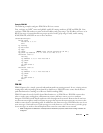
150 Multicast
When to Enable IP Multicast on the PowerConnect 6200 Series Switch
Use the IP multicast feature on the PowerConnect 6200 Series switch to route multicast traffic between
VLANs on the switch. If all hosts connected to the switch are on the same subnet, there is no need to
configure the IP multicast feature. If the switch does not handle L3 routing, you can use IGMP snooping
to manage port-based multicast group membership. For more information, see "IGMP Snooping" on
page 40. If the local network does not have a multicast router, you can configure the switch to act as the
IGMP querier. For more information, see "IGMP Snooping Querier" on page 43
IGMP Configuration
The Internet Group Management Protocol (IGMP) is used by IPv4 hosts to send requests to join (or
leave) multicast groups so that they receive (or discontinue receiving) packets sent to those groups.
In IPv4 multicast networks, multicast routers are configured with IGMP so that they can receive join and
leave request from directly-connected hosts. They use this information to build a multicast forwarding
table.
IPv6 multicast routers use the MLD protocol to perform the functions that IGMP performs in IPv4
networks.
CLI Example
The following example configures IGMP on a PowerConnect 6200 Series switch in order to route
multicast traffic between VLANs. IP routing, IP multicasting, and IGMP are globally enabled on the
router. Then, IGMP is configured on the selected interface(s).
console#configure
ip routing
ip multicast
ip igmp
interface vlan 2
routing
ip address 3.3.3.1 255.255.255.0
ip igmp
exit
exit
A multicast router must also have a way to determine how to efficiently forward multicast packets. The
information gathered by IGMP is provided to a multicast routing protocol (i.e., DVMRP, PIM-DM, and
PIM-SM) configured on the router to ensure that multicast packets are delivered to all networks where
there are interested receivers. Refer to those sections for configuration instructions.


















